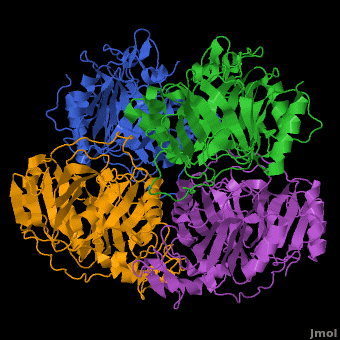Dioxygenase
From Proteopedia
Dioxygenases cleave the aromatic rings of their substrates by inserting two oxygen atoms, thus degrading these compounds. The dioxygenases are divided into 2 groups according to their mode of ring scission. The intradiol enzymes use Fe+3 as cofactor and cleave the substrate between 2 hydroxyl groups. The extradiol enzymes use Fe+2 as cofactor and cleave the substrate between a hydroxylated carbon and a non-hydroxylated one.
A Hyperactive Cobalt-Substituted Extradiol-Cleaving Catechol DioxygenaseAndrew J. Fielding, Elena G. Kovaleva, Erik R. Farquhar, John D. Lipscomb and Lawrence Que [1] Molecular Tour 2,3-HPCD catalyzes the cleavage of the C2-C3 bond of homoprotocatechuate (HPCA) with the incorporation of both oxygen atoms derived from O2 to form ring opened, 5-carboxymethyl-2-hydroxymuconic semialdehyde (5-CHMSA). Despite the significantly higher standard redox potential of Co(III/II) (1.92 V versus SHE) relative to that of the native metal Fe(II) (0.77 V), Co-HPCD was found to have more than twice the specific activity of Fe-HPCD under saturating O2 conditions, making Co-HPCD a hyper-active enzyme. The presence of is illustrated by the 4 strong anomalous difference peaks determined from the X-ray diffraction data set collected at the cobalt K-edge (Figure 4A, 1.6050 Å, 7.725 keV), which shows cobalt coordinated via . The structural comparison of the high-resolution X-ray crystal structures of Fe-HPCD (1.70 Å, 3ojt), Mn-HPCD (1.65 Å, 3ojn), and Co-HCPD (1.72 Å, 3ojj) shows environment as indicated by the RMSD values of 0.10-0.14 Å for superposition of . In addition, the presence of Co in the active site of HPCD has on either the or on the conformational integrity of the active site residues in. The absence of any observable structural differences upon metal substitutions suggests that differential redox tuning of the metal centers in this dioxygenase is highly unlikely. Rather, the 2,3-HPCD enzyme can carry out the O2 activation and oxidative ring-cleavage efficiently over a large range of metal redox potentials. The structural analysis supports the proposed mechanism described above in which the ability of the enzyme to activate molecular O2 does not correlate with redox potential of the metal center. However, the current results also show that the rates of individual steps in the overall catalytic cycle can be effected by the metal present in the active site of HPCD, resulting in a earlier rate-limiting step for Co-HPCD compared to Fe-HPCD and Mn-HPCD. | |||||||||||
3D structures of Protocatechuate 3,4-dioxygenase
Updated on 07-May-2015
Proteopedia Page Contributors and Editors (what is this?)
Michal Harel, Alexander Berchansky, Joel L. Sussman, Jaime Prilusky

